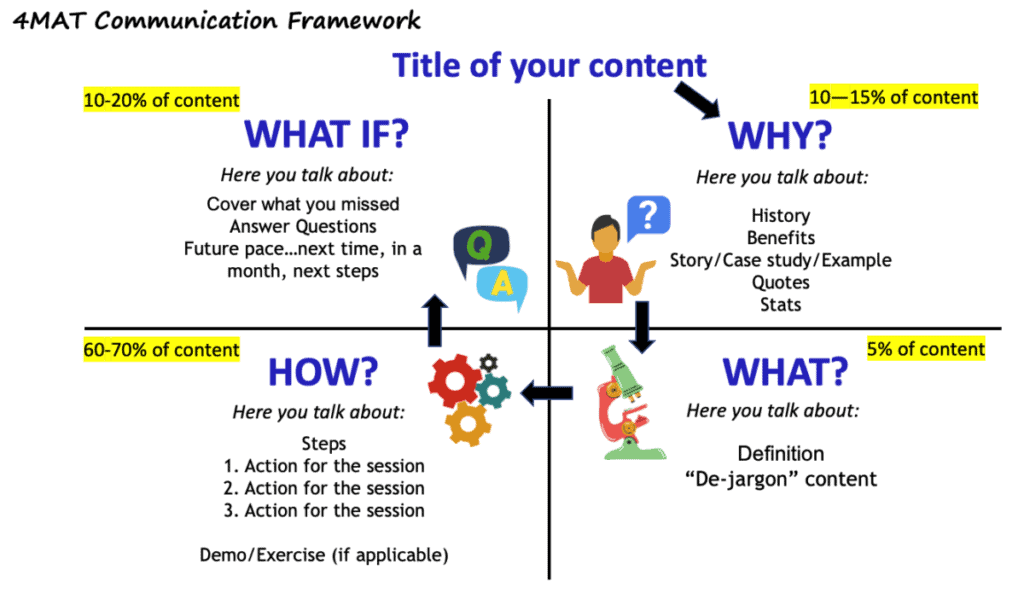You're Losing 75% Of Your Audience. (Here's How To Fix It)

Read Time: 3 Minutes
You’re midway through your presentation. The VP is checking his phone. Two people are whispering. Someone’s nodding off.
You’re losing them.
Not because your idea is bad. But because you’re only speaking to 25% of the room.
Let me explain.
The Problem: Everyone Learns Differently
Picture this: You’re presenting a new initiative to your team.
You jump straight into the data. Charts. Metrics. ROI projections.
Half the room checks out immediately. They’re thinking, “Why should I care?”
Or maybe you do the opposite. You spend 10 minutes explaining WHY this matters, setting context, painting the vision.
The analytical people are getting impatient. “Just tell me WHAT this is.”
Same problem, different approach. You’re only reaching the people who think like you.
Here’s what most people don’t realize: People learn in four different ways.
- Some need to know WHY it matters to them personally
- Others need the WHAT: give me the facts and data
- Some want HOW: show me the steps
- And others are thinking WHAT IF: how does this apply to my situation?
If you only speak to YOUR learning style, you lose everyone who thinks differently.
That’s 75% of your audience.
The Solution: The 4MAT Framework
This framework was developed by Dr. Bernice McCarthy in the late 1970s. She studied how people learn differently and found that we can all learn in all four ways, but we’re more dominant in one quadrant than the others.
When you structure your ideas to reach all four quadrants, you reach 100% of your audience.
Here’s how it works.

Quadrant 1 (top right): WHY
Who they are: Imaginative learners Their question: “Why does this matter to ME?” How to reach them: Start with engagement. Ask questions. Make it about them, not you.
Example: “Who here has ever struggled with keeping a team aligned on priorities?”
Quadrant 2 (bottom right): WHAT
Who they are: Analytical learners Their question: “WHAT is this exactly?” How to reach them: Share the framework. Give details. Be precise.
Example: “Here’s what our new prioritization system looks like—it’s a three-tier model based on impact and urgency.”
Quadrant 3 (bottom left): HOW
Who they are: Common sense learners Their question: “HOW do I apply this?” How to reach them: Show the process. Give examples. Make it tangible.
Example: “Here’s how you’ll use this in your next sprint planning meeting—step one, list all initiatives. Step two, rank them using this rubric.”
Quadrant 4 (top left): WHAT IF
Who they are: Dynamic learners Their question: “WHAT IF I use this in my context?” How to reach them: Facilitate discussion. Explore scenarios. Let them co-create.
Example: “So what does this mean for your team? How might you adapt this for remote collaboration?”
When you hit all four quadrants, you reach everyone in the room.
How To Use This Without Scripting Everything
Here’s the secret: you don’t need to memorize every word.
You use signposts.
Signposts are transitional phrases that tell your audience exactly where you are in the framework. They keep YOU from losing your place.
Quadrant 1 (WHY) Signposts: - “Let me ask you…” - “Have you ever…” - “Who here has experienced…”
Quadrant 2 (WHAT) Signposts: - “Here’s what this is…” - “The framework consists of…” - “Let me break this down…”
Quadrant 3 (HOW) Signposts: - “Here’s how you apply this…” - “The steps are…” - “Let me walk you through…”
Quadrant 4 (WHAT IF) Signposts: - “So what does this mean for you?” - “Imagine if…” - “How could you use this in your own…”
These signposts give you structure without sounding scripted. You can improvise within each quadrant, but the signposts keep you anchored.
(If you struggle with rambling between signposts, I wrote about how to stop rambling using the PES framework. It pairs perfectly with 4MAT.)
Inside The Impromptu Speakers Academy, we practice key frameworks like this in my 20-day self-paced program. You'll learn how to master speaking frameworks without needing to script or sound robotic. It's my flagship program to help you command the room and advance in your career.
Preston
